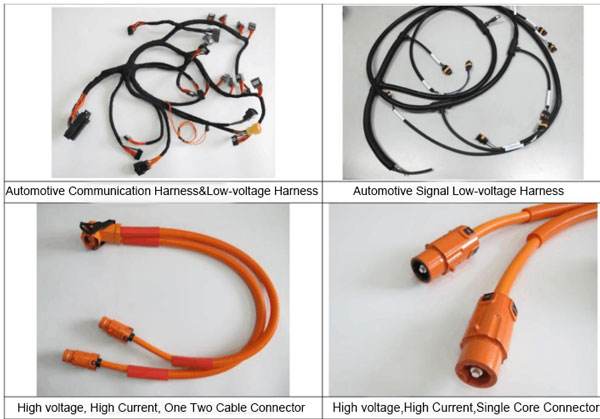Differences Between Car High-voltage and Low-voltage Connectors-Automotive Connector Terminals Manufacturer
Automotive connectors are divided into high-voltage and low-voltage connectors according to their working voltages. The working voltage of low-voltage connectors is mainly 12V, 24V, or 48V. The working voltage of high-voltage connectors reaches 60~800V or even higher.
Automotive electrical systems rely heavily on high-voltage and low-voltage connectors, which play a critical role in transmitting electrical signals and powering various circuits. While high and low-voltage connectors differ in their functions, working principles, structural designs, and applicable scenarios, understanding these differences is key to optimizing vehicle performance. In this article, we’ll delve into the key differences between high-voltage and low-voltage connectors and provide a detailed breakdown for your reference.
Differences Between High-voltage and Low-voltage Automotive Connectors

Functional Differences
High-voltage connectors, such as those used in ignition systems and fuel injection systems, are commonly used to transmit high-voltage power. They need to have good insulation properties and high-voltage resistance to ensure stable operation and circuit safety.
Low-voltage connectors are primarily utilized for transmitting low-voltage power and signals and connecting lighting systems and control units. Their structural design is often more intricate than high-voltage connectors, as they must account for a greater variety of signal transmission and control functions.
Working Principle
High-voltage connectors: High-voltage connectors usually use special materials and structural designs to prevent breakdown or arcing under high voltages. They may also be waterproof and dustproof to protect the circuitry from the outside environment.
Low-voltage connectors: Low-voltage connectors generally require good contact performance and reliability because they are often used to transmit complex signals and control circuits. In addition, low-voltage connectors also need to consider the number of mating times and the impact of connection stability on system performance.
Structural Design
High-voltage connector: High-voltage connectors usually have a simpler structure, mainly considering insulation performance and voltage resistance. It is generally composed of connector terminals, insulators, plastic shells, shielding rings, seals, covers, etc. Compared with low-voltage connectors, high-voltage connectors have internal and external shielding rings. After the high-voltage connector is assembled, the shielding ring will come into contact with the shielding layer on the connector shell, and the high-voltage wire shielding layer will eventually be grounded, thereby achieving 360° shielding protection for the high-voltage wires.
When it comes to low-voltage connectors, it’s crucial to prioritize the stability and reliability of signal transmission. These connectors typically boast numerous contact points and conductive materials to ensure optimal connection performance in even the most complex working environments. The structural composition of a low-voltage connector typically includes a tie rod, sealing ring, shell, TPA, and other essential structures.
Differences in Applicable Scenarios
High-voltage connector: High-voltage connectors are usually used in scenarios where high-voltage power needs to be transmitted, such as ignition systems and fuel injection systems. They need to have high voltage resistance and insulation properties to ensure the circuit’s safe operation.
Low-voltage connectors: Low-voltage connectors are widely used in scenarios where low-voltage power and signals are transmitted, such as lighting systems, connections between control units, etc. Wire harness terminals usually have relatively complex structural designs to meet complex signal transmission and control requirements.
In Conclusion
The progress of low-voltage connectors is headed towards high-speed data transmission, lightweight build, miniaturization, and integration. However, the advent of advanced car functions and the wide implementation of electronic control technology have led to an increase in electrical components and wires. Consequently, the number of circuits and power consumption in cars has risen considerably, making the wiring harness thicker and heavier. The challenge for car manufacturers now is to efficiently and logically arrange the numerous wire harnesses in limited car space, enabling the new energy wire harnesses to perform at their full potential. This remains a significant problem that needs solving.
As far as automotive connector terminals are concerned, suppliers play a crucial role in the entire development and even mass production process. They are required to have the ability to respond quickly and make engineering changes to meet the evolving needs of the automotive industry. However, with the rapid rise of the new energy vehicle market, some companies in the current low-voltage wire harness terminal market are no longer able to meet market demand due to their technical level and delivery capabilities. This is because automobile wiring harness terminals are no longer simply connecting devices, but higher-level components that integrate devices and control systems.
Hejustamping-Professional Automotive Connector Terminals Manufacturer

Heju Precision Electronic Technology Co., Ltd., based in Dongguan, specializes in the design and production of top-quality automotive connector terminals. Our company has achieved certification under three major systems, including ISO9001, ISO14001, and IATF16949. With years of expertise in connector terminals design and development, we boast a comprehensive quality inspection system to ensure that our products meet the standards of imported brands in terms of thermal and electrical conductivity. We are dedicated to customizing products to suit the specific needs of our customers and promoting domestic product substitution.
